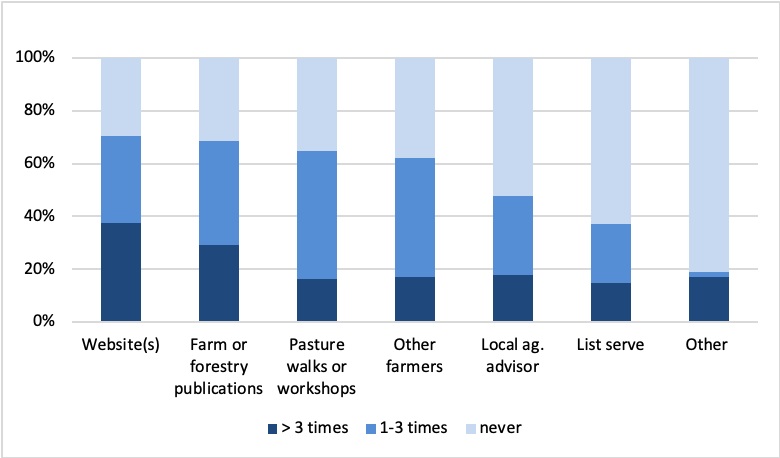Farmers and agricultural advisors in Wisconsin and surrounding states have shown increased interest in silvopasture in recent years. Given limited resources for silvopasture research and outreach it is helpful to know what information stakeholders want and how they want to receive it. From 2014 to 2019 we gathered evaluation data following silvopasture outreach events in Wisconsin and Minnesota and conducted twelve focus group interviews about silvopasture with more than 60 farmers, agricultural advisors, and foresters. These interviews and evaluation results provide a snapshot of where stakeholders learn about silvopasture, how they prefer to get silvopasture information, and what information they are seeking.
Where do stakeholders learn about silvopasture?
Farmers and resource professionals gave a range of answers to the interview question “Where did you first learn about silvopasture?” Several farmers first encountered the term at events held by a regional grazing network or through the authors’ Savanna Institute or Extension outreach in the past five years. Other farmers and most resource professionals first learned about silvopasture either through a university or when working or traveling in another part of the US or another country.
In the interviews all the respondents referred primarily to observations of silvopasture and woodland grazing at local farms when discussing benefits and challenges of the practice. However, while farmers and resource professionals value information from local farms most highly, they also use a variety of other information sources to learn about silvopasture. The evaluation forms distributed at silvopasture events asked where participants had found silvopasture information in the past year. Respondents reported that the internet was the most commonly accessed source of silvopasture information (Figure 1). This result contrasts with the interviews, where there was very little reference to the internet; in all the interviews there were just three references to the internet as a source of information -- one farmer mentioned a grazing website, one farmer had posted silvopasture information on the web, and one resource professional described the internet as a source of knowledge for “city kids.”

Figure 1. Responses (n=122) given in written evaluations following silvopasture events to the question “In the past year, how often have you used each of these sources for silvopasture information?”
However, in response to the evaluation question about where event participants like to get information about silvopasture, field day/pasture walk was the most popular response. Getting information from a website was either the second most popular response or tied for second place at each event. Finally, all the information channels are used by at least some respondents, and most respondents seek silvopasture information through multiple channels (Figure 2).

Figure 2. Responses (n=84) given in written evaluations following silvopasture workshops and conference sessions in 2017-19 to the question “How do you like to get or share silvopasture information?”
What additional knowledge do farmers and resource professionals want about silvopasture?
In both the interviews and evaluations we asked participants open-ended questions about what additional information they would like about silvopasture. The evaluation prompt was [if you plan to attend another educational event on silvopasture] “what topics would you like to learn about in future workshops?” The interview prompt varied depending on context but also did not suggest specific topics.
Overwhelmingly, both farmers and resource professionals wanted more information about how to manage silvopasture in Wisconsin. Requests ranged from general requests for management guidance to specific questions such as what forage species to plant. Table 3 lists the topics that were requested five or more times.
In addition to requests for silvopasture management recommendations and information, respondents asked for specific research and education approaches, including many requests for local demonstration sites and case studies. There were also numerous requests for information on the economics and environmental impacts of silvopasture.
Table 3. Top silvopasture information requests
|
Topic |
# of requests |
||||
|
Trees and Forages |
|
||||
|
|
What tree and shrub species are best suited? (planting or retaining) |
12 |
|||
|
Tree establishment in pasture |
7 |
||||
|
|
What are the good forage species? (including native species) |
10 |
|||
|
Livestock |
|
||||
|
|
Livestock other than cattle, including poultry, goats* |
8 |
|||
|
How do you properly manage grazing? |
5 |
||||
|
General management and planning of silvopasture |
|||||
|
Management of shrubs, weeds, and invasive species |
8 |
||||
|
Site identification, mapping, and planning |
7 |
||||
|
General management |
5 |
||||
|
Research & Educational Approaches |
|
||||
|
|
Demonstration sites & case studies |
10 |
|||
|
Economics |
|
||||
|
|
Economics |
8 |
|||
|
Local markets for tree products |
7 |
||||
|
Environmental Impacts |
|
||||
|
|
Impacts on water quality, infiltration, and runoff |
5 |
|||
*This information request follows workshops, pasture walks, and conference presentations focused on silvopasture for beef cattle
Conclusion
Farmers and resource professionals in the upper Midwest are increasingly aware of and interested in silvopasture. Both groups expressed a desire for locally-based silvopasture information and rated pasture walks on local farms as the preferred form of information delivery. However, websites were the most commonly used information source, and respondents reported using a variety of silvopasture information sources, presumably balancing preference, availability, and convenience.
Acknowledgments
Funding for this research was provided by the Kickapoo Valley Reforestation Fund, USDA NIFA Hatch Project 1006564, and USDA NIFA McIntire-Stennis Project WIS0181.
Thanks to the farmers and resource professionals who gave their time in interviews and filled out voluntary evaluations.

